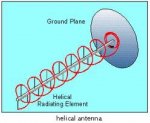Hi folks.

I am using a Radiometrix NTX2 434.650MHz 25mW transmitter module(driven by an 18M2 PICAXE), and the datasheet gives some examples of antennas, including a helical one made out of 0.5mm enameled copper wire, close-wound on a 3mm former.
However, this antenna is too floppy and easily bent/damaged when placing the unit in the wall - the antenna sticks up completely clear from the product, but the entire thing lives inside the wall cavity, so can brush up against bats(the insulation!), primarily during installation, and this bends the aerial out of shape. YES - I could use SMA encapsulated aerials, and will do this if there is no easy solution in the re-wind department.
So, I want to wind another one, using THICKER wire - such as 1.25mm enameled copper winding wire - this will be thick enough that the aerial cannot be EASILY bent out of shape like the current ones can.
BUT - as all those with any RF training know, you can't just change the diameter of the wire used to wind a helical, as it is part of the equation.
So, I had a look around on the net, and there are plenty of on-line calculators to work it out for you, but they make no mention of the wire size(guage).
I will continue to search the net...
I don't suppose anyone here has any links to a calculator which would allow me to enter in the wire size to use, and IDEALLY, the number of turns, but the latter does not really matter to me, except that a helical will less turns is lower-profile. I THINK, that as the number of turns comes down at a given frequency, the diameter of the turns you are using increases in size - i think - I might be totally wrong there, but I seem to remember something like that years ago when I was reading about radio theory...
I am using a Radiometrix NTX2 434.650MHz 25mW transmitter module(driven by an 18M2 PICAXE), and the datasheet gives some examples of antennas, including a helical one made out of 0.5mm enameled copper wire, close-wound on a 3mm former.
However, this antenna is too floppy and easily bent/damaged when placing the unit in the wall - the antenna sticks up completely clear from the product, but the entire thing lives inside the wall cavity, so can brush up against bats(the insulation!), primarily during installation, and this bends the aerial out of shape. YES - I could use SMA encapsulated aerials, and will do this if there is no easy solution in the re-wind department.
So, I want to wind another one, using THICKER wire - such as 1.25mm enameled copper winding wire - this will be thick enough that the aerial cannot be EASILY bent out of shape like the current ones can.
BUT - as all those with any RF training know, you can't just change the diameter of the wire used to wind a helical, as it is part of the equation.
So, I had a look around on the net, and there are plenty of on-line calculators to work it out for you, but they make no mention of the wire size(guage).
I will continue to search the net...
I don't suppose anyone here has any links to a calculator which would allow me to enter in the wire size to use, and IDEALLY, the number of turns, but the latter does not really matter to me, except that a helical will less turns is lower-profile. I THINK, that as the number of turns comes down at a given frequency, the diameter of the turns you are using increases in size - i think - I might be totally wrong there, but I seem to remember something like that years ago when I was reading about radio theory...


